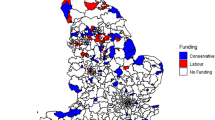Abstract
We explore the idea that the influence of interest groups in elections may have positive economic effects. Since the investment decisions of firms determine economic growth and employment, voters have a common interest in making their governments commit to policies that encourage private investments. However, governments may renege on promises for economic stability and choose excessively leftist policies. Campaign contributions by firms tend to restrain the scope for such opportunism and provide a commitment device. This is achieved if firms, after the policy is chosen, contribute to the governing party or to its rivals.
Similar content being viewed by others
References
Alogoskoufis, G., Giavazzi, F., & Laroque, G. (1995). The two phases of Janus: institutions, policy regimes, and macroeconomic performance in Greece. Economic Policy, 10(20), 147–192.
Ansolabehere, S., de Figueiredo, J. M., & Snyder, J. (2003). Why is there so little money in U.S. politics? Journal of Economic Perspectives, 17(1), 105–130.
Austen-Smith, D. (1987). Interest groups, campaign contributions and probabilistic voting. Public Choice, 54, 123–139.
Bartels, L. (1993). Messages Received: The political impact of media exposure. American Political Science Review, 87(2), 267–285.
Becker, G. (1983). A theory of competition among pressure groups for political influence. Quarterly Journal of Economics, 98(3), 371–400.
Bonilla, C. (2004). A model of political competition in the underlying space of ideology. Public Choice, 121, 51–67.
Bordo, M. D., & Rockoff, H. (1996). The gold standard as a housekeeping seal of approval. The Journal of Economic History, 56(2), 389–428.
Coate, S. (2004a). Pareto improving campaign finance policy. American Economic Review, 94(3), 628–655.
Coate, S. (2004b). Political competition with campaign contributions and informative advertising. Journal of the European Economic Association, 2(5), 772–804.
Crain, M. (2001). Institutions, durability and the value of political transactions. In W. Shughart & L. Rozzolini (Eds.), The Elgar companion to public choice (pp. 183–196). Northampton: Edward Elgar Publishing.
Denzau, A., & Munger, M. (1986). Legislators and interests groups: how unorganized interests get represented. American Political Science Review, 80(1), 89–106.
Dimitras, P. E. (1985). Greece: a new danger. Foreign Policy, 58, 134–150.
Dixit, A. (1996). The making of economic policy, a transaction cost politics perspective. Cambridge: MIT Press.
Dougan, W., & Munger, M. (1989). The rationality of ideology. Journal of Law and Economics, 32(1), 119–142.
Friedman, M. (1990). Bimetallism revisited. Journal of Economic Perspectives, 4(4), 85–104.
Golden, M. (1986). Interest representation, party systems and the state: Italy in comparative perspective. Comparative Politics, 18, 279–301.
Grier, K. (2001). In W. Shughart & L. Rozzolini (Eds.), The Elgar companion to public choice (pp. 310–327). Northampton: Edward Elgar Publishing.
Haber, S., Razo, A., & Maurer, N. (2003). The politics of property rights. Cambridge: Cambridge University Press.
Iyengar, S., & Simon, A. F. (2000). New perspectives and evidence on political communication and campaign effects. Annual Review of Psychology, 5, 149–169.
Kiewiet, R., & Rivers, D. (1984). A retrospective on retrospective voting. Political Behavior, 6(4), 369–393.
Kramer, G. H. (1971). Short-term fluctuations in U.S. voting behavior, 1896–1964. American Political Science Review, 65(1), 131–143.
Kynland, F., & Prescott, E. (1977). Rules rather than discretion: the inconsistency of optimal plans. The Journal of Political Economy, 85(3), 473–492.
Landes, W., & Posner, R. (1975). The independent judiciary in an interest-group perspective. The Journal of Law and Economics, 18(3), 875–901.
Levitt, S. (1995). Policy watch: congressional campaign finance reform. Journal of Economic Perspectives, 9(1), 183–193.
Monroe, K. (1979). Econometric analyses of electoral behavior: a critical review. Political Behavior, 1(2), 137–173.
Mueller, D., & Stratmann, T. (1994). Informative and persuasive campaigning. Public Choice, 81, 55–77.
Noyes, A. (1905). The recent economic history of the United States. Quarterly Journal of Economics, 19(2), 167–209.
Persson, T., & Tabellini, G. (2000). Political economics: explaining economic policy. Cambridge: MIT Press.
Prat, A. (2002). Campaign advertising and voter welfare. Review of Economic Studies, 69(4), 999–1017.
Przeworski, A., & Wallerstein, M. (1988). Structural dependence of the state on capital. American Political Science Review, 82, 11–29.
Sadiraj, V., Tuinstra, J., & van Winden, F. (2006). A computational electoral competition model with social clustering and endogenous interest groups as information brokers. Public Choice, 129, 169–187.
Snyder, J., & Ting, M. (2005). Interest groups and the electoral control of politicians. Mimeo, February.
Tsakalotos, E. (1998). The political economy of social democratic economic policies: the PASOK experiment in Greece. Oxford Review of Economic Policy, 14(1), 114–138.
Tsakalotos, E., & Lyberaki, A. (2002). Reforming the economy without society: social and institutional constraints to economic reform in post-1974 Greece. New Political Economy, 7(1), 93–114.
Voulgaris, Y. (2002). Greece of the-post dictatorship period: 1974–1990: stable democracy marked by the history of this era. Athens: Themelio Press.
Winkler, A. (2003). ‘Other people’s money’: corporations, agency costs, and campaign finance law. Georgetown Law Journal, 92, 871–940.
Author information
Authors and Affiliations
Corresponding author
Rights and permissions
About this article
Cite this article
Maniadis, Z. Campaign contributions as a commitment device. Public Choice 139, 301–315 (2009). https://doi.org/10.1007/s11127-009-9394-2
Received:
Accepted:
Published:
Issue Date:
DOI: https://doi.org/10.1007/s11127-009-9394-2




